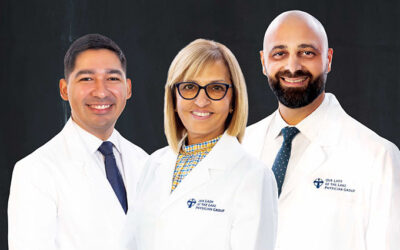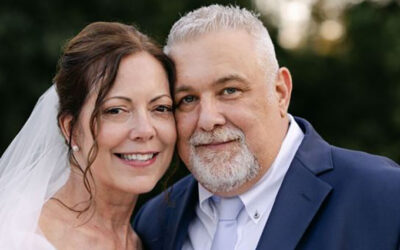It was a routine day in June 2019 when Jessica Pannell dropped off her daughter at daycare. But, within minutes, things took a drastic turn. Pannell couldn’t see the papers to sign her daughter in for the day. When she tried to wave goodbye, she could barely make out her child’s shape and features.
“I thought maybe I was just frazzled because it was a busy morning,” Pannell says. “After I drove to the parking garage at work, I just sat in my car for a second. I realized things weren’t getting better. I didn’t have peripheral vision. If I squinted I could see a little, but I knew it wasn’t normal.”
Pannell is a supervisor in the executive administration offices at Our Lady of the Lake Regional Medical Center. Once she realized the situation was serious, she called her boss from her vehicle. Hospital staff were at her car within minutes and helped her walk to the emergency room.
A CT scan and other tests showed that Pannell had suffered a stroke at just 29 years old.
“The possibility of having a stroke was not even on my radar,” she says. “I didn’t understand how that could happen. I was totally shocked when the scan came back.”
Stroke at a Young Age
Although strokes still occur most often in older adults, they have become more common in younger individuals in recent years, says Dr. Gary Walker, a vascular neurologist and medical director of the stroke program at Our Lady of the Lake. In Pannell’s case, doctors suspected that a medication she was taking at the time increased her stroke risk. Dr. Walker says that for other individuals, risk factors such as high blood pressure, diabetes, high cholesterol and tobacco use may be part of the reason for the increased stroke cases in younger patients.
“We typically see strokes in older adults because those risk factors accumulate over time,” he says. “Now we are seeing those same risk factors catch up to people at younger ages, thus leading to strokes.”
Advances in Stroke Care
Fortunately, stroke treatments have also advanced significantly in recent years. Dr. Walker says it is crucial that someone suspected of having a stroke is brought to a hospital as soon as possible. In fact, doctors often say that “time is brain,” meaning that a patient may experience more long-term neurological effects if treatment is delayed.
“It’s all about removing the blood clot that caused the stroke as quickly as possible,” Dr. Walker says. “The first medications to dissolve the clots were approved in the 1990s and have been reformulated since then to be more effective. As doctors, we’ve also gotten better at recognizing the signs of a stroke more quickly and administering that medication.”
In addition, Dr. Walker says some patients undergo a thrombectomy, a procedure in which doctors use a catheter to remove the blood clot.
“That technique has only been available in the last 15 years or so,” he says. “Since that time, we have had better devices become available to remove clots, along with better processes to identify patients who need this procedure and treat them as soon as possible.”
‘BE FAST’ to Recognize Signs of Stroke
Dr. Walker says the most common signs of a stroke can be identified using the phrase “BE FAST.” These include balance and walking issues, eye movement and vision changes, facial drooping, arm weakness and speech difficulty. The “T” in the phrase reinforces that time is of the essence for a person with these symptoms to receive medical treatment.
Most patients do not experience significant symptoms prior to a stroke, although the problems can quietly develop over time as arteries narrow. In some cases, people may have transient ischemic attacks (TIAs), or mini-strokes. These are temporary episodes of neurological symptoms that can be warning signs of a larger stroke to come.
“My doctors did say the tests showed I may have had a smaller stroke before the major one,” Pannell says. “There had been one day, probably within the year, where I had a few moments where I couldn’t walk. It felt like my legs were locked up. It didn’t last very long. I saw a neurologist who told me that everything was fine. I’ll never really know if that was a mini-stroke or if the incidents were connected, but in hindsight, I do wish that I had pushed a little harder for more tests. The whole experience has made me realize how much I need to listen to my body.”
Personalized Recovery
Like many stroke patients who receive immediate treatment, Pannell has recovered well in the five years since her stroke, although she still has some vision loss that is likely permanent. However, she left the hospital the day after her stroke and did not need therapy.
“The post-stroke rehabilitative therapy process is very dependent on the person,” Dr. Walker says. “We treat about 2,000 stroke patients here every year and everyone has an individual plan. Some people need physical therapy to help with mobility and walking. Some need occupational therapy to relearn how to do day-to-day activities. Everyone is evaluated by a speech therapist to make sure they have language skills and can communicate well. Some people need more of one therapy than another. But, everyone leaves the hospital with a plan that is tailored for them.”
Thankful for Each Day
Pannell says she has remained committed to regular checkups with her physician and is not afraid to speak up if something in her body doesn’t feel right. But, mostly, she is thankful for each day, no matter the challenges it may bring.
“I do have moments where I get a little stressed, but I try to be grateful because I know how quickly things can change. I try to not get too bothered about anything,” she says. “I’m thankful that I’m still able to see. I’m still able to drive and work and watch my daughter grow up. I know it could have been a lot worse.”
Our Lady of the Lake is the region’s first and largest Primary Stroke Center, earning its initial certification in 2012. The hospital has earned The Joint Commission’s Gold Seal of Approval and the American Heart Association/American Stroke Association’s Heart-Check mark for Advanced Certification for Primary Stroke Centers.




